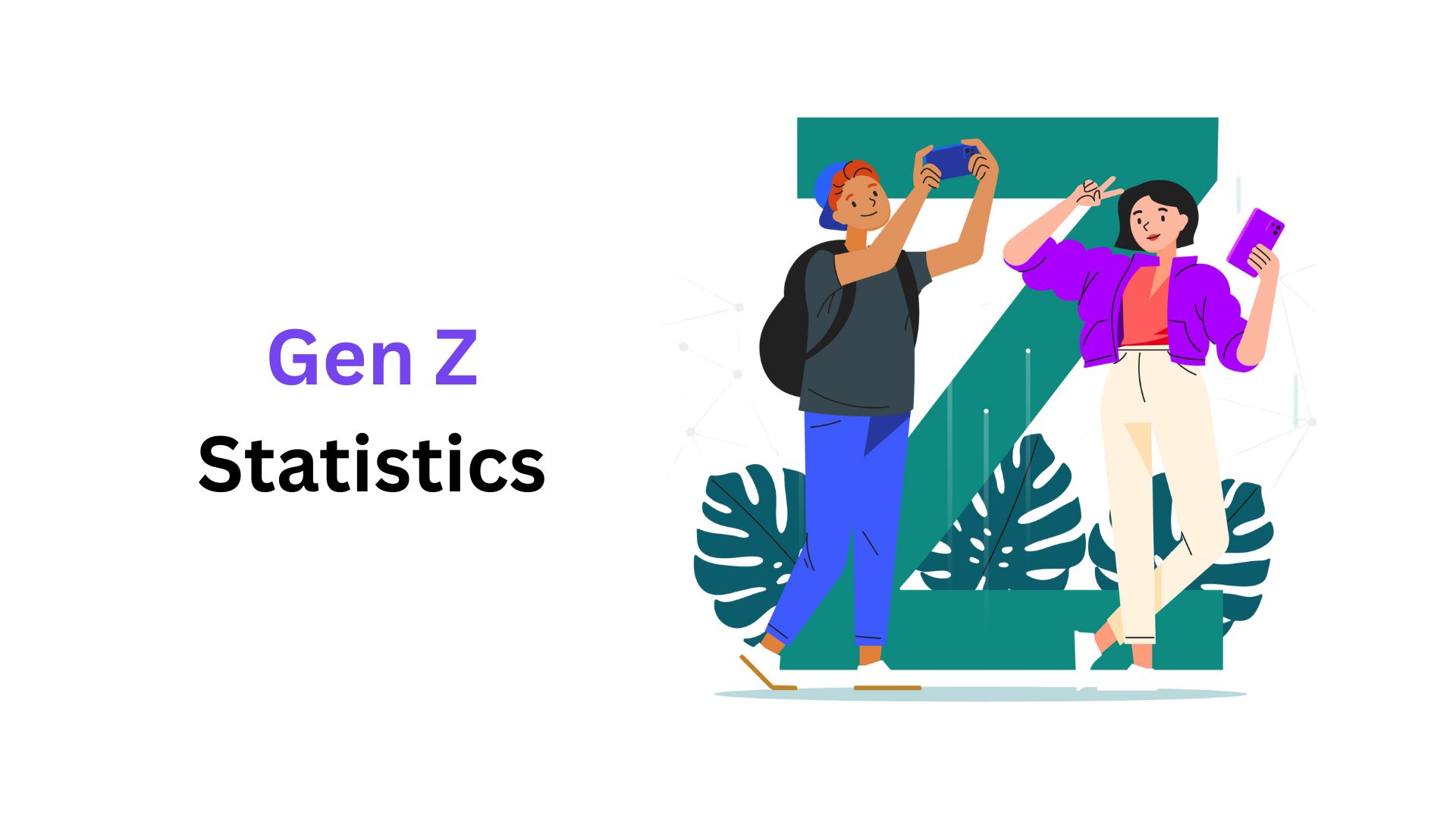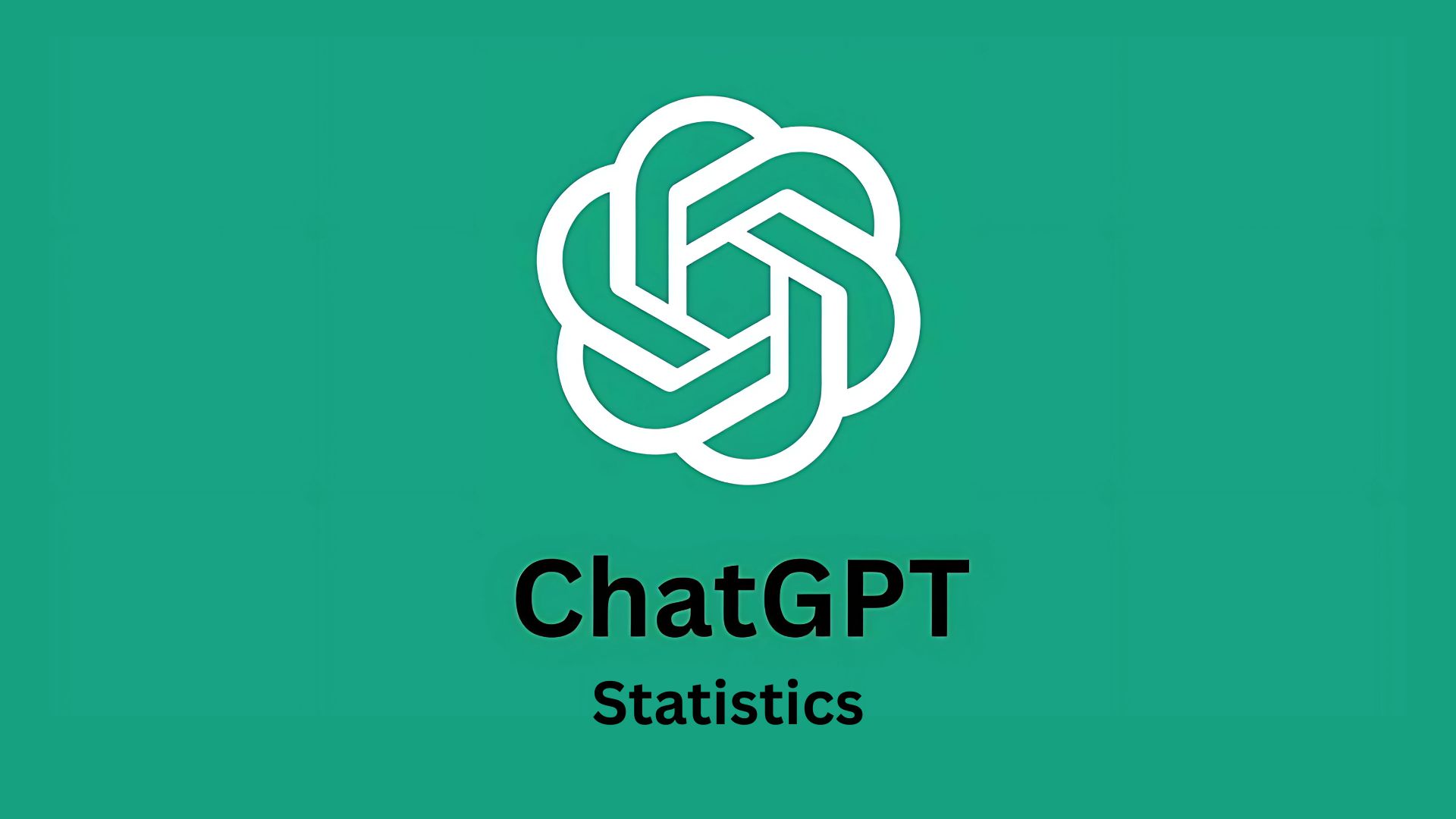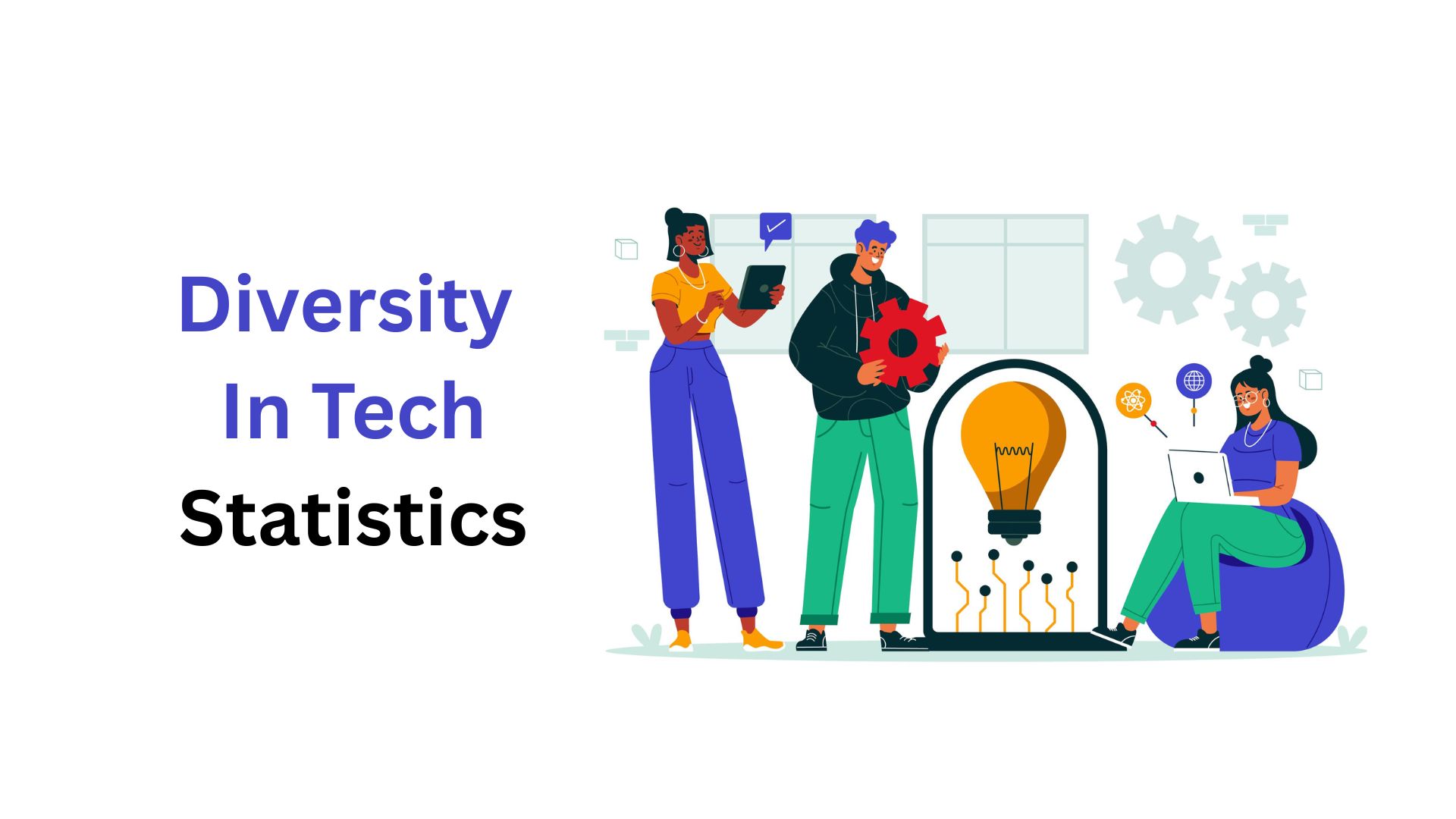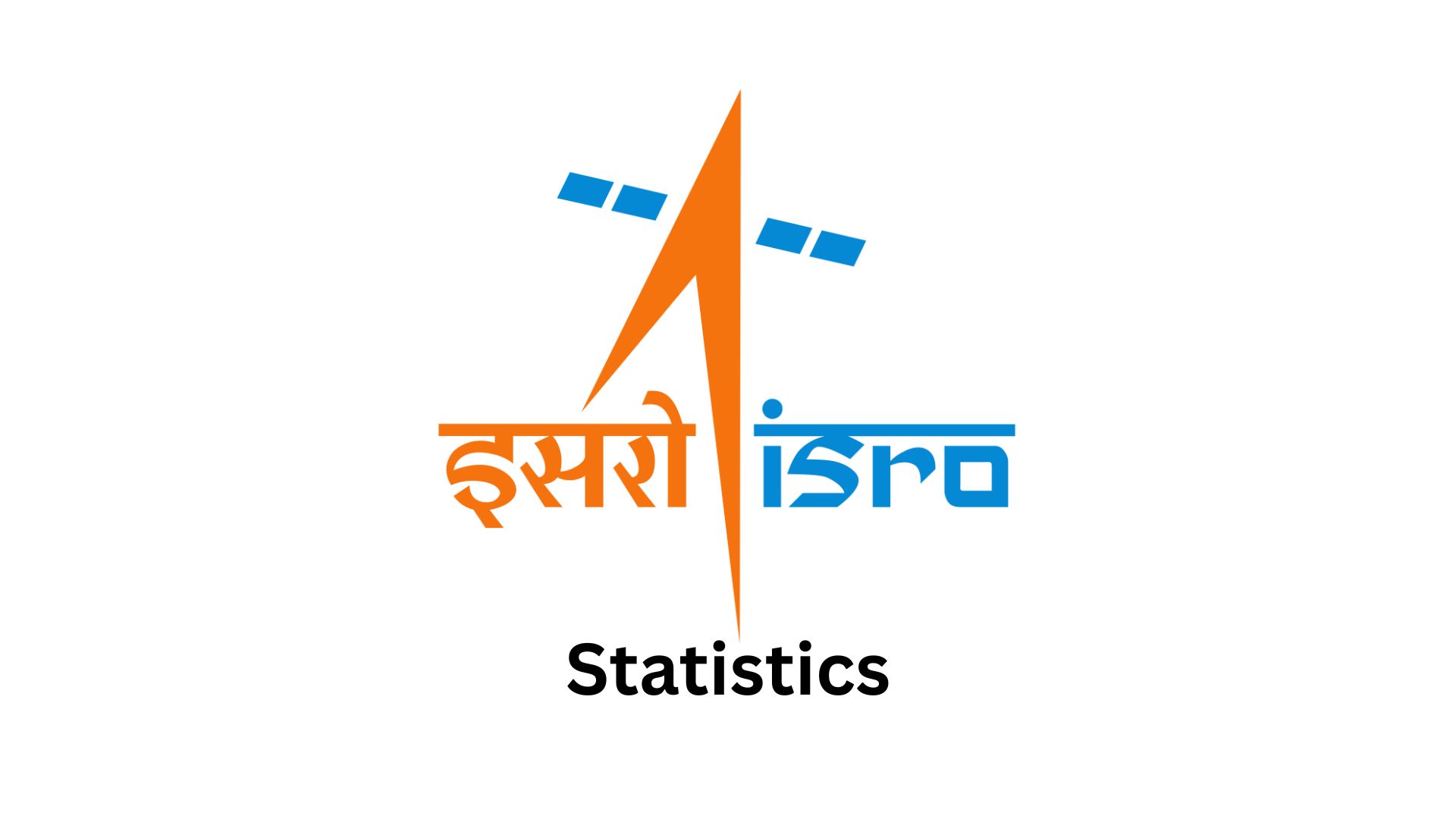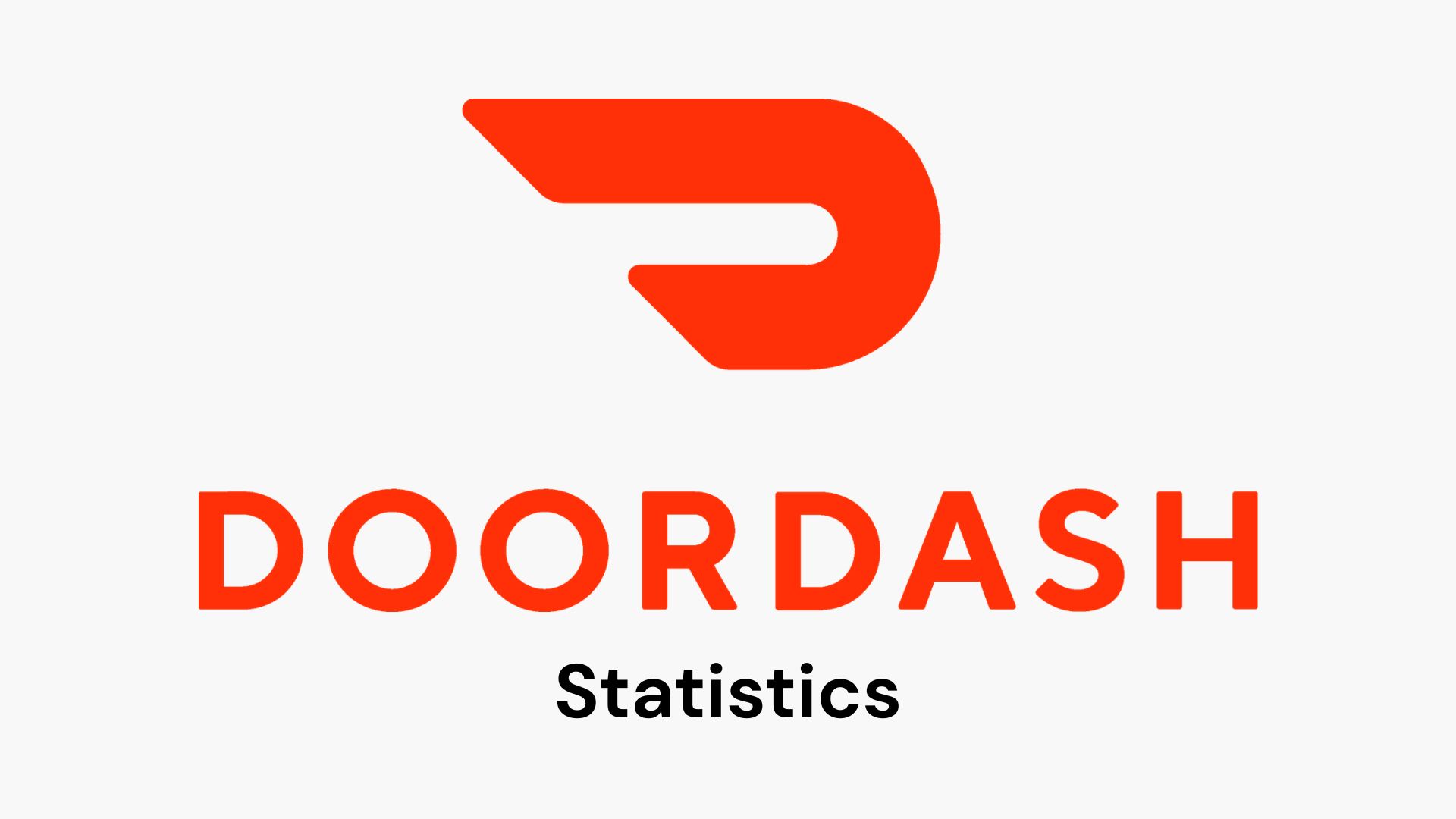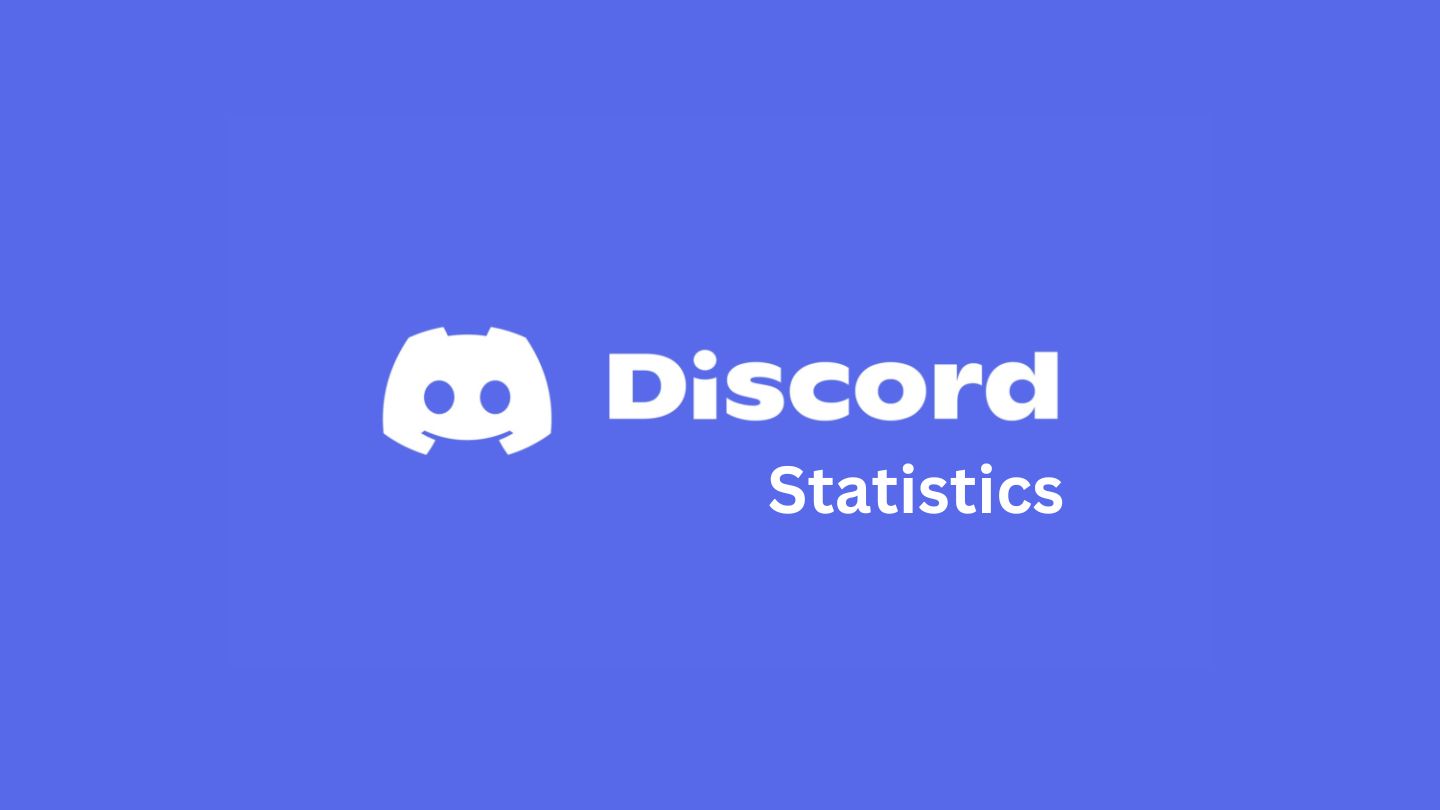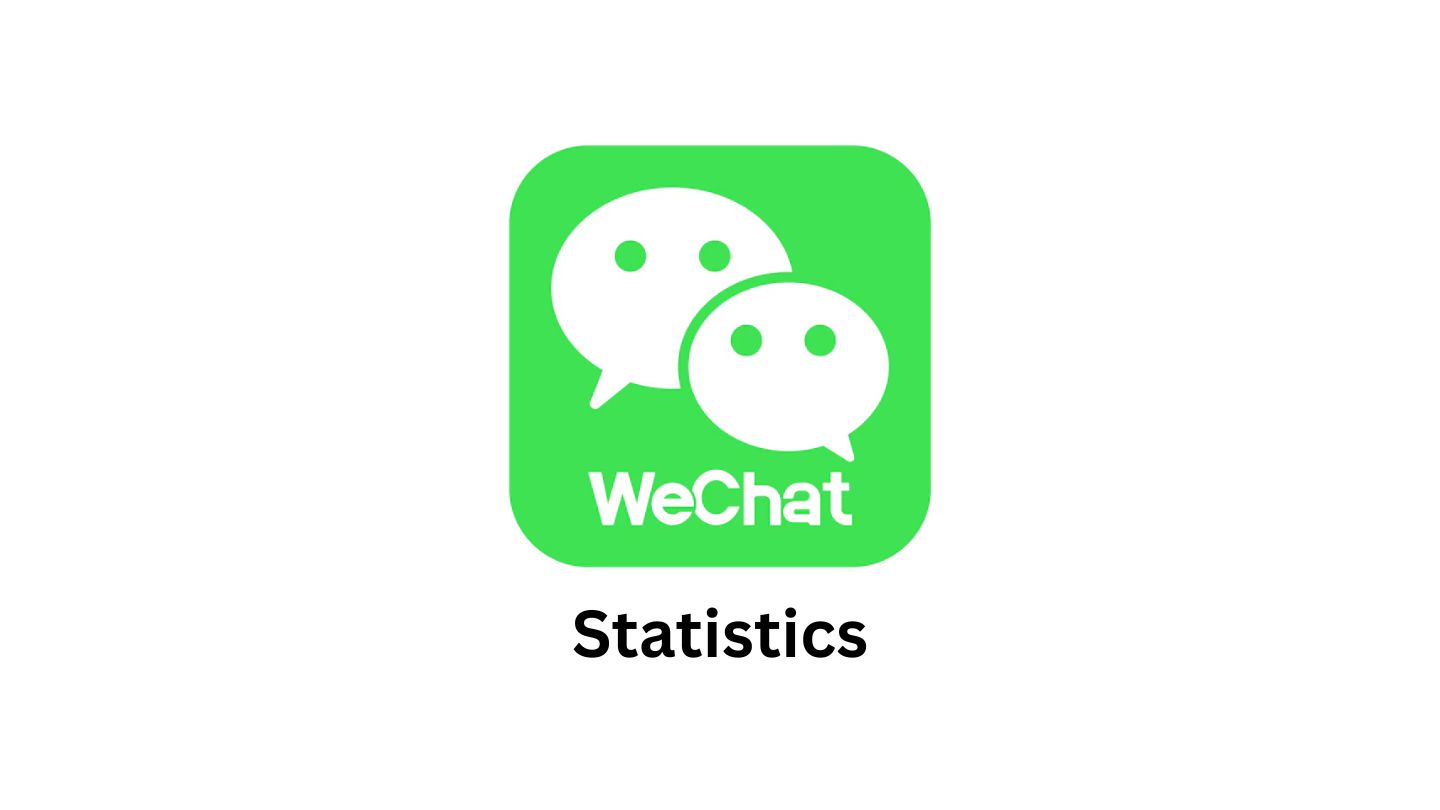Generative AI Statistics By Worth, Market Size, Revenue, Companies and Facts
Updated · Dec 04, 2024

Table of Contents
- Introduction
- Editor’s Choice
- Generative AI’s Impact on Business
- Generative AI’s Impact Across Industries
- Generative AI’s Impact on Labor
- Risk of AI Adoption in India
- Generative AI Adoption in The Market
- Professional Adoption of AI For Marketing Companies
- Generative AI Usage by Demographics
- Company’s Preparation of Generative AI
- Generative AI Market Size
- PR Professional Using Generative AI
- Artificial Intelligence Companies
- Investment in Generative AI
- Generative AI Future Projections
- Conclusion
Introduction
Generative AI Statistics: Generative AI is a dynamic form of artificial intelligence that focuses on the development of content that deals with text, audio, and relevant data production. For the most part, it is an intelligence form of computer rational intelligence that focuses on predicting and generating the most probable dataset.
By going through the Generative AI Statistics, one can have a glance at the growth story of this technology and what the future holds for it. Likewise, one will learn about the essential information revolving around large language models.
Editor’s Choice
- Data privacy is the top concern, with 72.9% of respondents marking it as the primary risk in AI adoption for marketing in India.
- 9% believe AI will enhance marketing without replacing human creativity, showing optimism about AI-human collaboration.
- 93% of marketers expect generative AI to revolutionize practices and create new opportunities.
- CEOs (32%) and CMOs (31%) are organizations primary leaders responsible for AI adoption.
Generative AI’s Impact on Business
- According to a Google survey of 50 technology businesses, 64% are interested in adopting generative AI.
- Gartner reports that businesses could reduce costs by 15.7% over the next 12 to 18 months through generative AI investment.
- Businesses that use generative AI for writing responses to customer service requests save on average 2 hours and 11 minutes per day.
- Gartner also highlights a potential productivity boost of 24.69% from generative AI adoption within the next 12 to 18 months.
- Botco states that 73% of marketing departments use generative AI for various applications.
- The most common uses among marketers are image generation (69%), text creation (58%), audio production (50%), chatbots (37%), and coding (36%).
- HubSpot notes that chatbots help businesses save an average of 2 hours and 20 minutes daily, allowing more focus on tasks requiring human interaction.
- 44% of businesses utilize generative AI for cloud pricing optimization and 41% for developing voice assistants, chatbots, and conversational AI.
- Deloitte’s survey of 2,620 global businesses revealed that 94% of business executives believe AI will enhance their operations within the next five years.
- According to the Financial Times, 92% of Fortune 500 companies are using OpenAI’s technology, with over 2 million software developers from these companies building on OpenAI’s API.
Generative AI’s Impact Across Industries
- By 2025, artificial intelligence is expected to power approximately 95% of business interactions globally, according to Servion Global Solutions.
- The global artificial intelligence market could reach a value of USD 190 billion by 2025.
- Global spending on generative AI may hit USD 110 billion in 2024.
- Deloitte predicts that 90% of businesses in the customer service industry will adopt generative AI by 2025.
- Currently, over 74% of organizations in the customer service sector are testing or deploying customer chatbots.
- Generative AI adoption in the retail industry is projected to grow at an annual CAGR of 39% by 2026.
- Artificial intelligence adoption in retail stood at USD 2.7 billion in 2019 and is expected to grow almost eightfold in seven years.
- By 2025, more than 50% of the global supply chain management industry may adopt artificial intelligence, including key sectors like manufacturing, retail, transportation, and logistics.
- About 55% of the supply chain management industry is anticipated to lead AI adoption by 2025.
- It is estimated that 19 out of 20 customer interactions will be AI-assisted by 2025, according to AI Business.
Generative AI’s Impact on Labor
- 84% of American jobs are vulnerable to automation by generative AI, as stated by LinkedIn, defining vulnerability as more than one-quarter of job functions being automatable.
- Nearly 10% of U.S. jobs are at high risk of replacement by generative AI by 2029, according to a Bureau of Labor Statistics report from July 2022.
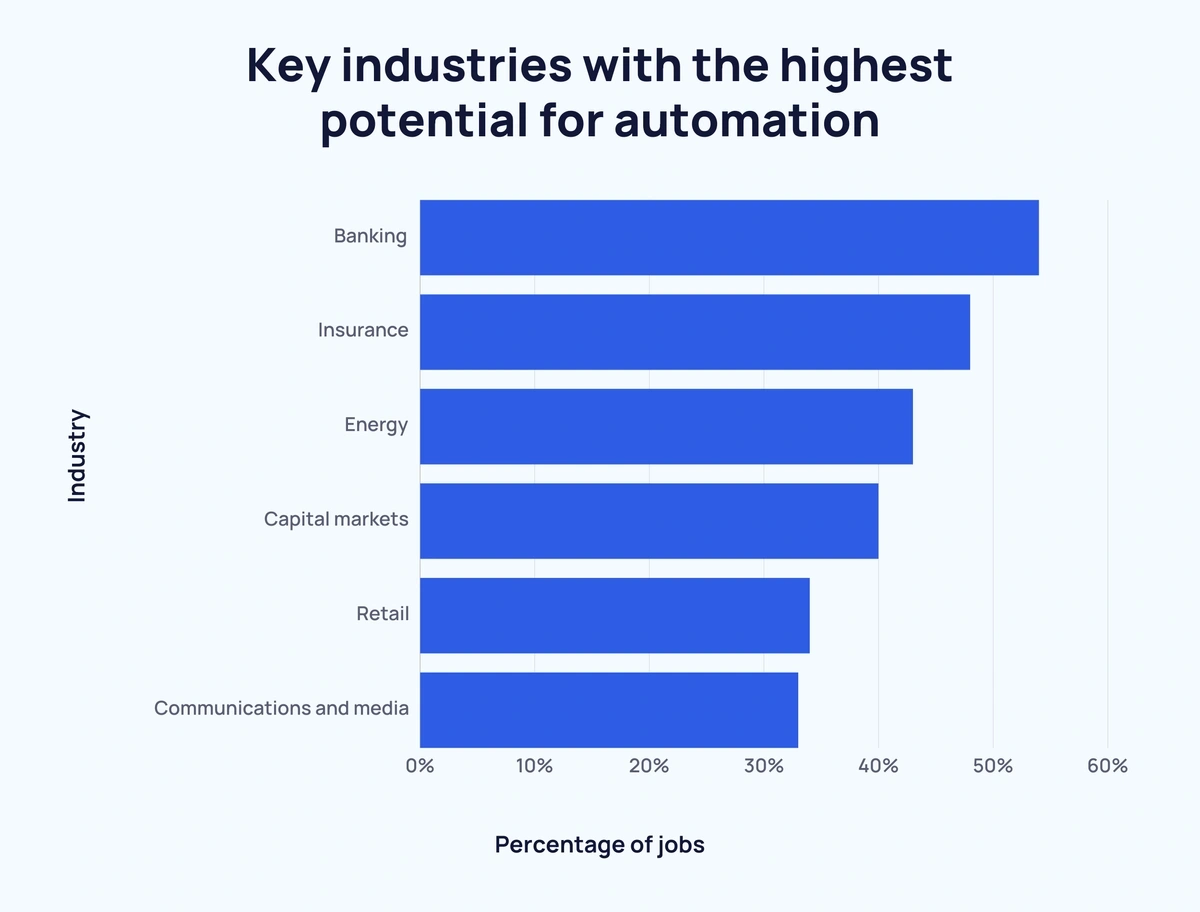
- 25% of companies globally are using AI to address labor shortages, a measure that automates repetitive tasks, as found in a 2022 IBM study.
- Just 3% of the skills required for software engineering are resistant to automation by generative AI, mainly people and specialized skills, according to LinkedIn.
- Generative AI could replace 85 million jobs worldwide by 2025, as forecasted by the World Economic Forum.
- Conversely, AI could create as many as 97 million new jobs by 2025, leading to a net job creation rate of 12 million, also forecasted by the World Economic Forum.
- AI and machine learning jobs are predicted to be among the fastest-growing fields between 2023 and 2027, according to the World Economic Forum.
- Administrative roles such as executive secretaries, and positions like accounting clerks and security guards, are among the careers AI could eliminate by 2027.
- 61% of workers are already using or plan to use generative AI in their job functions, as indicated by a McKinsey report.
- Programmers utilizing generative AI tools like Github’s CoPilot are 88% more productive, achieving faster speeds in coding tasks and improving code quality confidence by 85%.
Risk of AI Adoption in India
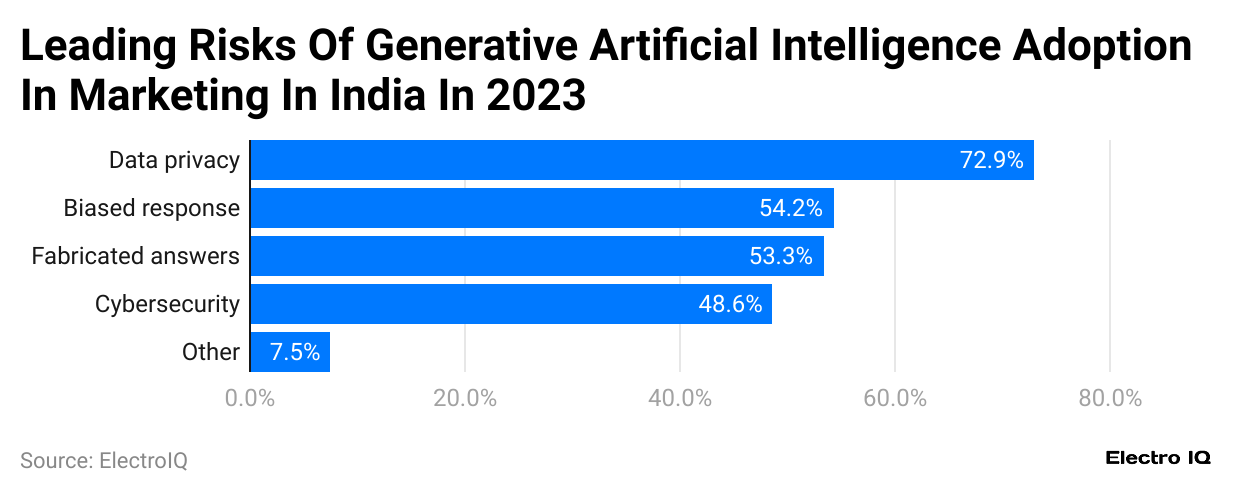
(Reference: statista.com)
- Generative AI Statistics show that while generative AI offers powerful tools for marketing, there are serious apprehensions about its implications for data security and ethical considerations, which marketers prioritize over other potential risks like bias, fabrication, and cybersecurity.
- 9% of respondents consider data privacy as the primary risk, indicating widespread concerns about how generative AI might handle sensitive information.
- Only 7.48% of marketers indicated other unspecified risks, showing that the primary concerns are well-defined among the majority.
Generative AI Adoption in The Market
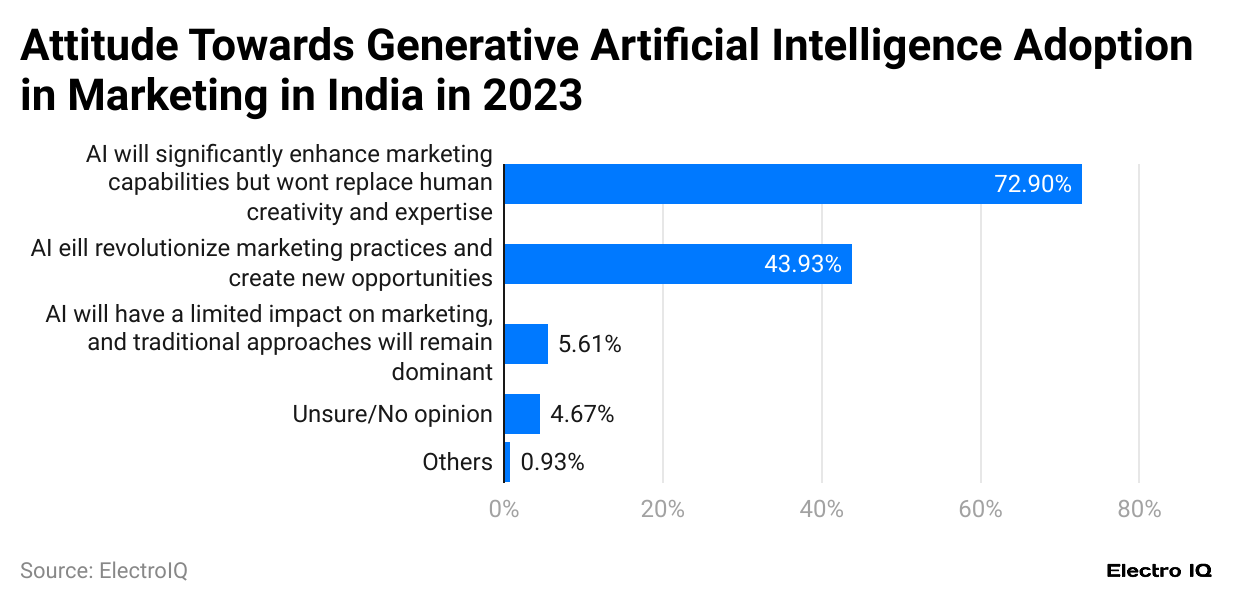
(Reference: statista)
- Generative AI Statistics show that marketers in India are highly optimistic about the role of generative AI in enhancing marketing capabilities, with the majority viewing it as a tool that will augment existing efforts without replacing human creativity and expertise. This highlights a positive attitude toward AI adoption, balanced with an understanding of the unique value of human input.
- 9% of respondents believe that AI will significantly enhance marketing efforts but will not replace human creativity, emphasizing a view of AI as a complementary tool rather than a replacement.
- 93% of marketers expect generative AI to revolutionize practices and create new opportunities, indicating a strong belief in its transformative potential within the industry.
- Only 5.61% feel AI will have a limited impact on marketing, suggesting that most marketers anticipate substantial influence from AI. A small portion, 4.67%, remains unsure or has no opinion, and 0.93% have other unspecified views, showing that while optimism prevails, there is still a fraction of uncertainty regarding AI’s exact role in marketing.
Professional Adoption of AI For Marketing Companies
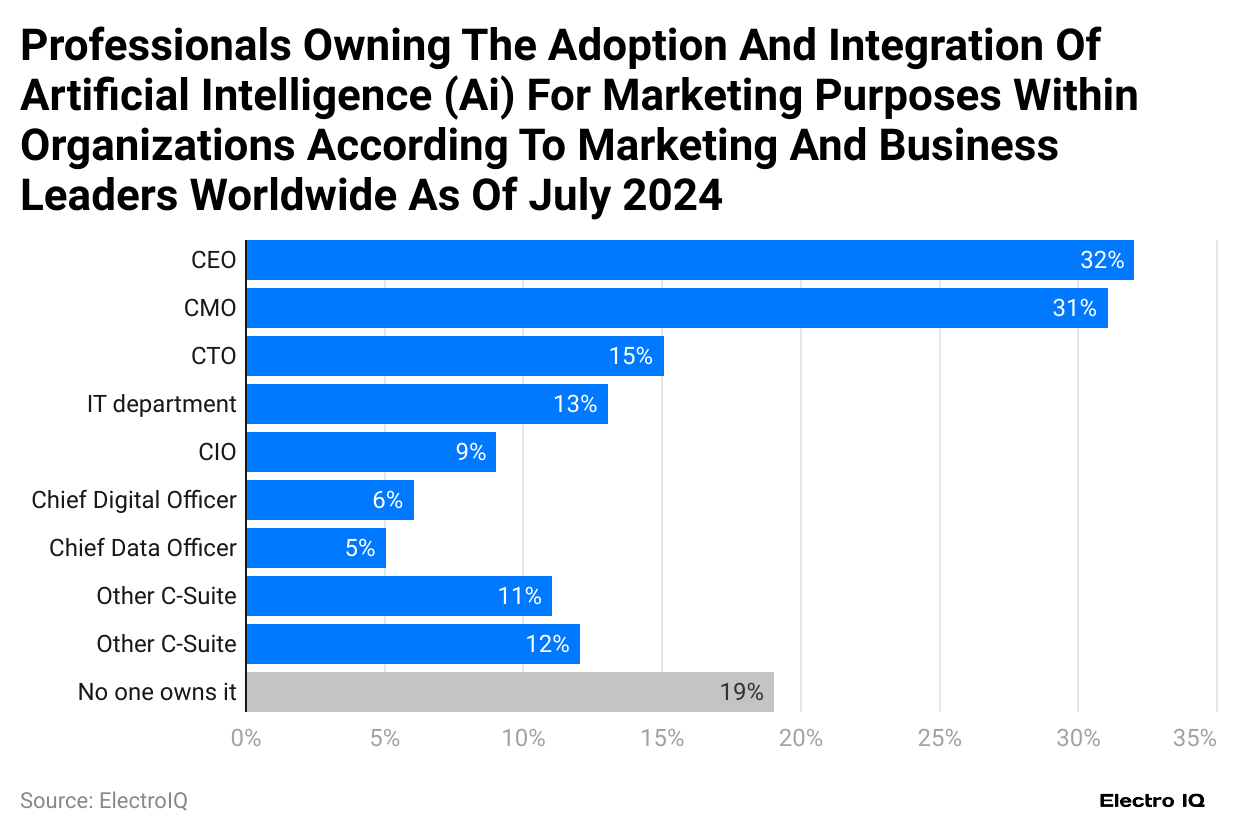
(Reference: statista)
- Generative AI Statistics show that ownership of AI adoption for marketing purposes within organizations is primarily led by top executives, with CEOs and CMOs being the most responsible for driving AI integration. This suggests that AI in marketing is seen as a strategic priority requiring executive-level leadership and decision-making.
- The largest shares of responsibility lie with the CEO (32%) and CMO (31%), indicating that strategic oversight and marketing expertise are crucial for AI initiatives.
- The CTO and IT department hold a combined 28% (15% for CTO and 13% for IT), showing that technical teams are also significantly involved in AI implementation. Other roles, like the Chief Digital Officer (6%) and Chief Data Officer (5%), have smaller shares, reflecting that while specialized digital and data positions contribute, they are not the primary owners.
- Interestingly, 1% of organizations reported that “No one owns it,” indicating a gap in ownership, which could impact the success and cohesion of AI adoption efforts within these companies.
Generative AI Usage by Demographics
- 70% of Gen Z have used generative AI tools, according to Salesforce. Gen Z includes people born during the late 1990s and early 2000s.
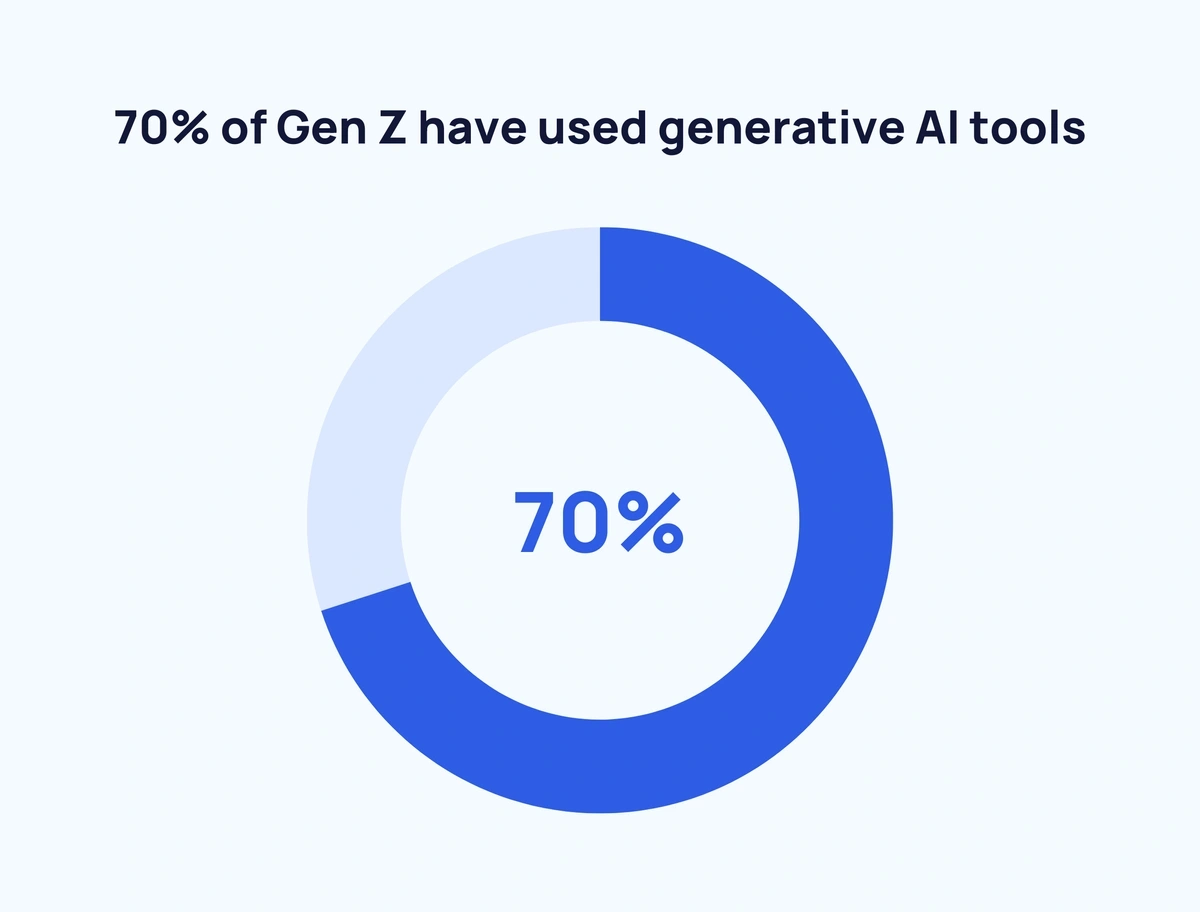
- 68% of consumers unfamiliar with generative AI are from Gen X and the Baby Boomer generation, as reported by Salesforce.
- 40% of individuals from Gen X and Baby Boomer generations don’t know much about generative AI.
- 32% of individuals from Gen X and Baby Boomer generations don’t find generative AI useful.
- Men are twice as likely as women to use generative AI, according to Forbes.
- ChatGPT, the world’s most popular generative AI platform, had an average of 1.5 billion monthly visits in 2023. Of these, 69.5% were men, while 30.5% were women.
- Men are seven times as likely as women to allow their kids to use generative AI tools. About 31% of men feel comfortable letting their children use AI chatbots like ChatGPT, compared to only 4% of women.
- 44% of women feel it is impossible to regulate generative AI, compared to 23% of men who share the same opinion.
Company’s Preparation of Generative AI
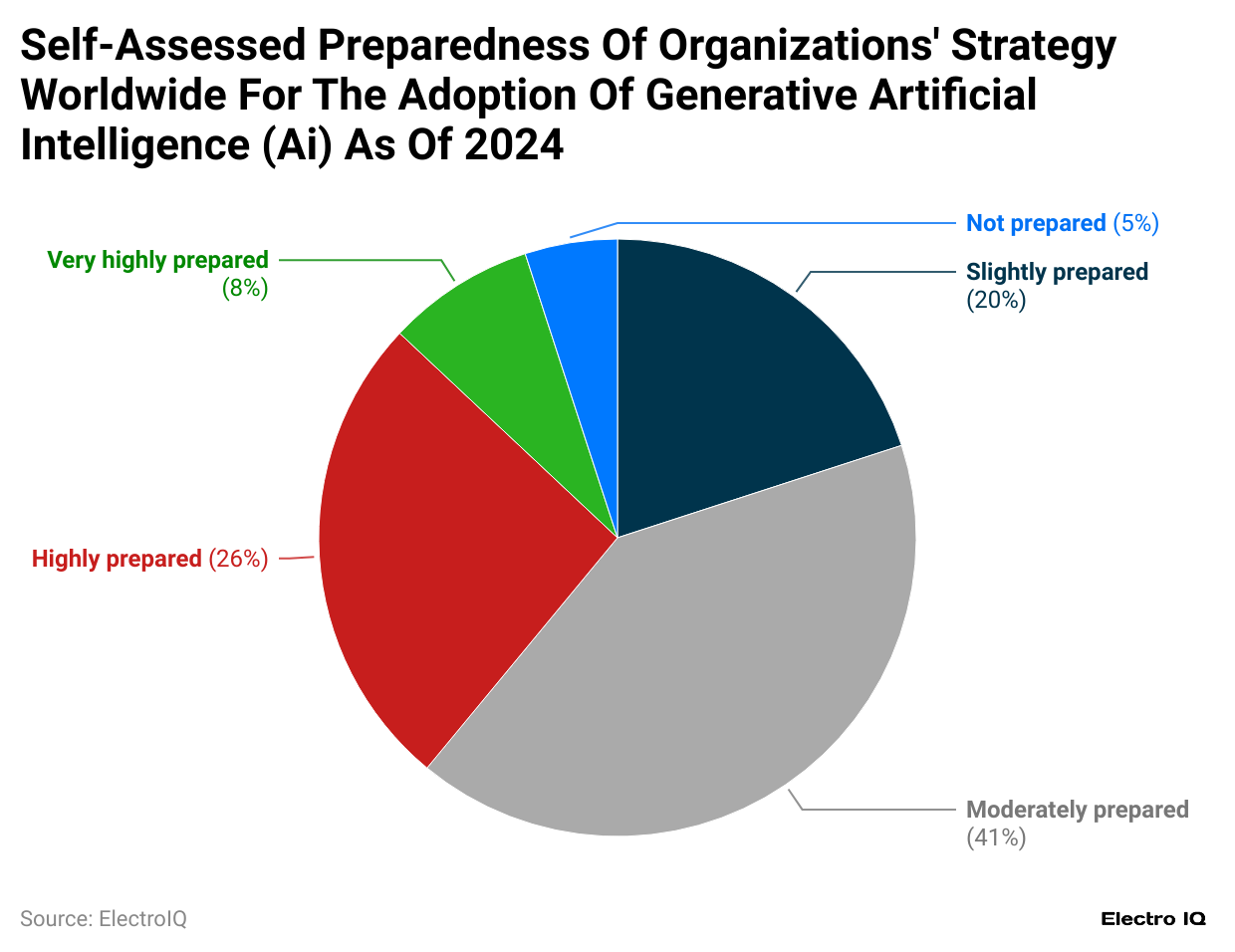
(Reference: statista.com)
- Generative AI Statistics show that most organizations worldwide consider themselves at least moderately prepared for adopting generative AI, with only a small fraction feeling highly prepared.
- 41% of organizations rate themselves as “Moderately prepared,” indicating that many companies are working towards readiness but may still need to build stronger capabilities or frameworks for effective AI integration. A combined 34% of organizations feel “Highly prepared” (26%) or “Very highly prepared” (8%), showing a substantial minority with strong confidence in their AI adoption strategies.
- Only 5% of respondents report being “Not prepared,” which implies that a lack of preparedness is relatively uncommon, with most organizations already making strides in AI readiness.20% of organizations feel “Slightly prepared,” suggesting that while these organizations recognize AI’s importance, they still have significant steps to take to implement and utilize it fully.
Generative AI Market Size

- The Generative AI market is expected to grow from USD 13.5 billion in 2023 to USD 255.8 billion by 2033, with a compound annual growth rate (CAGR) of 34.2%.
- North America held a dominant position in 2023 with 42.1% market share and USD 5.6 billion in revenue.
- The software segment led the market, constituting 66.7% of revenue in 2023 due to high demand and continuous model enhancements.
- The transformer technology segment held the largest revenue share at 45.1% in 2023, with a projected CAGR of 32.2%, driven by its versatility in language processing and image generation.
- Large language models dominate the generative AI model segment and are expected to see significant growth, while computer vision is anticipated to have the fastest CAGR, propelled by applications in transportation and surveillance.
- Media and entertainment held a 24.3% market share in 2023, leveraging generative AI for image and video creation.
- In 2023, natural language processing (NLP) led the market by applications, with sustained growth projected, while computer vision is expected to expand rapidly due to its adoption in multiple sectors.
- Generative AI is projected to boost the United States GDP by 21% by 2030.
- A study from leading business schools revealed generative AI can increase employee productivity by up to 40%.
- Generative AI has the potential to increase US labor productivity by 0.5% to 0.9% points annually through 2030.
- Enterprise generative AI tools are expected to transform the banking sector, adding an estimated annual value of USD 200 billion to USD 340 billion.
- Total funding for generative AI startups was projected to reach USD 6 billion in 2023, indicating strong investor interest.
- Downloads of generative AI tools were expected to surpass 10.1 million by mid-2023, up from 1.1 million in 2022.
- Over 75% of consumers are concerned about misinformation stemming from AI.
- ChatGPT reached approximately 1 million users within its first five days of launch.
- 64% of businesses believe AI will significantly enhance productivity.
- China leads in AI adoption, with 58% of companies already using AI and 30% considering adoption, compared to 25% usage and 43% interest in the United States.
- India has the highest adoption rate of generative AI among surveyed countries, with 73% of respondents using the technology, followed by Australia (49%), the US (45%), and the UK (29%).
- Millennials and Gen Z make up 65% of generative AI users, with 72% of them being employed.
- Nearly 6 in 10 generative AI users feel they are close to mastering the technology.
- 70% of Gen Z reported using generative AI, with 52% trusting it to help make informed decisions.
- 52% of users report increasing their usage of generative AI over time.
- 75% of users aim to use generative AI for automating work tasks and communications.
- 38% use generative AI for fun or experimentation, while 34% use it for learning about topics of interest.
- Among marketers, the most common uses of generative AI include basic content creation (76%), writing copy (76%), inspiring creative thinking (71%), analyzing market data (63%), and generating image assets (62%).
PR Professional Using Generative AI
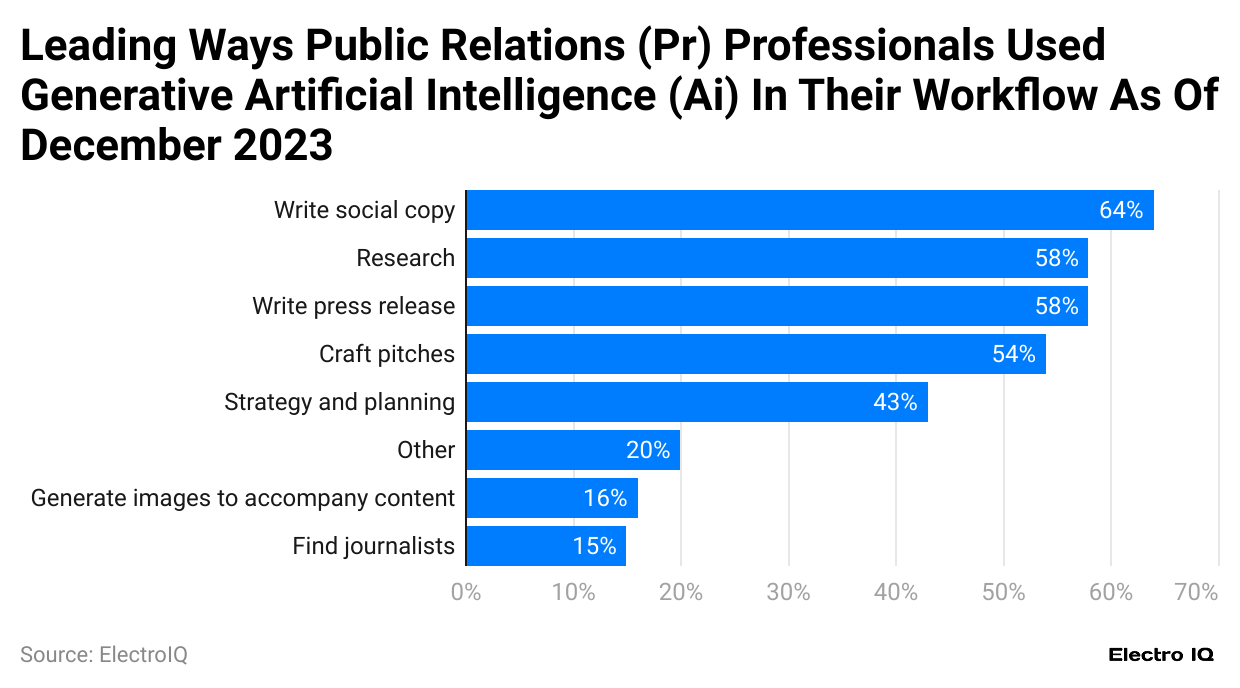
(Reference: statista.com)
- Generative AI Statistics show that it is widely used by public relations (PR) professionals to support various content creation tasks, particularly for social media, research, and press releases. This indicates that AI is primarily leveraged to streamline and enhance writing-focused activities within PR workflows.
- The most common use of generative AI is for writing social media copy, with 64% of PR professionals utilizing it in this capacity, reflecting the high demand for quick, engaging social content. Both research and press release creation are also popular uses, with 58% of respondents using AI for each task. This suggests that AI aids significantly in gathering information and preparing official communications.
- 54% of professionals use AI for crafting pitches, showing its value in creating persuasive and tailored content for media outreach. 43% of PR professionals use it for strategy and planning, indicating that AI tools support content creation and broader PR planning activities.
- Tasks like generating accompanying images (16%) and finding journalists (15%) are less frequently supported by AI, possibly due to the specialized nature of these tasks requiring more human judgment.
Artificial Intelligence Companies
- Writesonic
- Moonshot AI
- Peak (company)
- Researcher
- AI21 Labs
- Neurotechnology (company)
- Perplexity AI
- Onpassive
- Butler Technologies
- Blue Prism
- Berkshire Grey
- Anthropic
- Australian Artificial Intelligence Institute
- Netvibes
- Inflexion AI
- Glean Technologies
- Agility Robotics
- CoreWeave
- Isomorphic Labs
- Draft
- Algemeen
- Spectre AI
- Element AI
- Matador Network
- BabyX
- Researcher
- Caper AI
- Mind Foundry
- Zhipu AI
- Talent Automation Platform
- Discover
- AI
- RAIC Labs
- Artisse AI
- 4Paradigm
- ICaarbonX
- Covariant (company)
- Writesonic
- MiniMax (company)
- Runway (company)
- Aleph Alpha
- Microsoft
- Art Recognition
- LocAI
- Replika
- Fable Studio
- Cohere
- Dicta (organization)
- Clearance
- Synthesia (company)
- XAI (company)
- UiPath
- Asteria Aerospace
- ai
- Vectra AI
- Gcore
- BabyX
- Covariant
(Source: wikipedia.org)
Investment in Generative AI
- Total investment in generative AI surged by 407% from 2022 to 2023, reaching USD 21.8 billion across 426 deals, compared to USD 4.3 billion in 2022. Companies focused on generative AI infrastructure received 77.5% of this total investment.
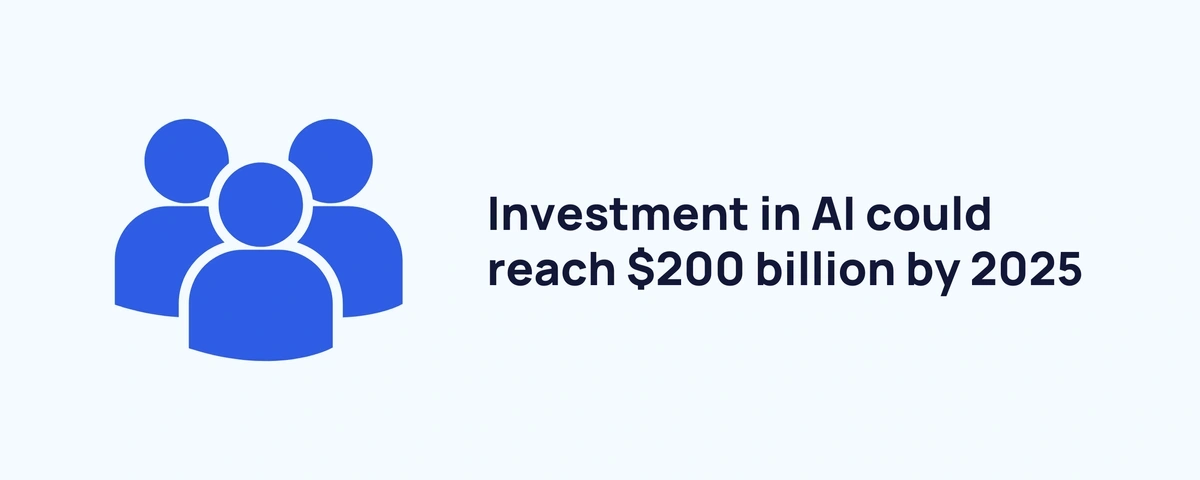
(Source: Exploding Topics)
- Private equity investment in generative AI increased by 118% from 2022 to 2023. In 2022, USD 1 billion was invested across 35 deals, while in 2023, the investment rose to USD 2.18 billion across 22 deals. This demonstrates a significant increase in deal value despite the decrease in the number of transactions.
- According to Goldman Sachs, investment in artificial intelligence could reach USD 200 billion by 2025. Researchers have noted that substantial investment is likely to precede the productivity impacts of generative AI.
- A KPMG survey of 220 companies revealed that 43% of US companies generating at least USD 1 billion annually plan to invest USD 100 million or more in generative AI. This reflects a proactive approach despite uncertainty regarding the full range of benefits.
Generative AI Future Projections
- By 2026, 90% of online content might be generated by AI, according to Europol.
- Generative AI is projected to contribute up to USD 4.4 trillion annually to the global economy, equivalent to 4.2% of the current global GDP of approximately USD 105 trillion.
- Among the G8 countries in 2022, only the United States (25%) and Japan (4.2%) contributed more than 4.2% to the global GDP, meaning generative AI could surpass the contributions of Germany, Canada, France, Italy, Russia, and the United Kingdom.
- AI may independently develop 15% of new applications by 2027, according to Gartner.
- By 2024, 60% of the global population could interact with AI technology, knowingly or unknowingly, according to Forrester.
- AI adoption in workplaces could streamline workflows and eliminate repetitive tasks.
- While AI could lead to efficient content creation, it may not necessarily result in higher-quality content.
Conclusion
The landscape of generative AI shows remarkable growth and transformation across industries, particularly in marketing and PR. Generative AI Statistics show an increasing adoption and revenue, with global figures expected to surge from $128 billion in 2023 to over $1 trillion by 2031. The industry shows a balanced approach to AI adoption, with high social media content and research utilization, while maintaining cautious integration in more specialized tasks.
This comprehensive overview suggests a future where AI becomes increasingly integral to business operations while maintaining human oversight and creativity.
Sources
FAQ.
Data privacy is the primary concern, with 72.9% of respondents identifying it as the main risk.
The revenue is expected to reach $1.166 trillion by 2031.
CEOs (32%) and CMOs (31%) are the primary leaders responsible for AI initiatives.
64% use it for writing social media copy, making it the most common application.
41% feel moderately prepared, while 34% feel highly or very highly prepared.
From $128 billion in 2023, it’s projected to reach $457 billion by 2027.

Saisuman is a skilled content writer with a passion for mobile technology, law, and science. She creates featured articles for websites and newsletters and conducts thorough research for medical professionals and researchers. Fluent in five languages, Saisuman's love for reading and languages sparked her writing career. She holds a Master's degree in Business Administration with a focus on Human Resources and has experience working in a Human Resources firm. Saisuman has also worked with a French international company. In her spare time, she enjoys traveling and singing classical songs. Now at Smartphone Thoughts, Saisuman specializes in reviewing smartphones and analyzing app statistics, making complex information easy to understand for readers.

